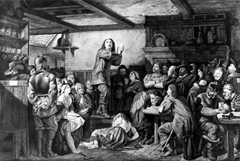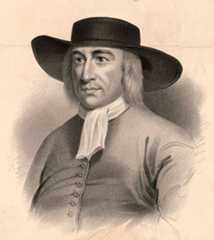Society of Friends
Our editors will review what you’ve submitted and determine whether to revise the article.
- Sacred Destinations - Notre Dame Cathedral, Paris, France
- Bryn Mawr College - Quakers and the Underground Railroad: Myths and Realities (PDF)
- The Victorian Web - Quakers. The Society of Friends in Victorian Britain
- The Encyclopedia of Greater Philadelphia - Religious Society of Friends (Quakers)
- Texas State Historical Association - Religious Society of Friends
- United States Holocaust Memorial Museum - Quakers
- World Religions and Spirituality Project - The Quakers
- Hartford Institute for Religion Research - Encyclopedia of Religion and Society - Quakers
- American Humanist Association - Quakers: Paths to Humanism (PDF)
- CARM - Quakers, The Friends Church, Religious Society of Friends
- CALS Encyclopedia of Arkansas - Religious Society of Friends
What is the Society of Friends?
The Society of Friends, also known as Friends Church or Quakers, is a Christian group that arose in mid-17th-century England, dedicated to living under the “Inward Light,” or direct inward apprehension of God, without creeds, clergy, or other ecclesiastical forms.
Which American presidents had a family background with the Society of Friends?
Herbert Hoover and Richard M. Nixon were the two American presidents with a family background in the Society of Friends.
Who was the founder of the Society of Friends?
George Fox was the founder of the Society of Friends. He is considered so chiefly because of the system of meetings for church business that he established in the years immediately after 1667, which essentially stands today. Most important is the monthly meeting, which considers all applications for membership, may manage properties, and acts on members’ concerns.
What do members of the Society of Friends believe?
Members of the Society of Friends pursue knowledge of and a direct relationship with the divine. The principles that Friends feel arise from the guidance of the Teacher, which Friends call “testimonies,” generally include peace (often manifesting in avowed pacifism), equality, simplicity, community, and care for the earth.
Why are members of the Society of Friends known as Quakers?
George Fox recorded in 1650 that “Justice Bennet of Derby first called us Quakers because we bid them tremble at the word of God.” Originally derisive, it was also used because many early members of the Society of Friends trembled and showed other physical manifestations of religious emotion in their religious meetings. No embarrassment is caused by use of the term today.
News•
Society of Friends,Christian group that arose in mid-17th-centuryEngland, dedicated to living in accordance with the “Inner Light,” or direct inwardapprehension of God, without creeds,clergy, or otherecclesiastical forms. As most powerfully expressed byGeorge Fox (1624–91), Friends felt that their “experimental” discovery of God would lead to the purification of all of Christendom. It did not. But Friends founded one American colony and were dominant for a time in several others, and, though their numbers are now comparatively small, they have made disproportionate contributions to science, industry, and especially to the Christian effort for social reform.
History
The rise ofQuakerism
There were meetings of the kind later associated with the Quakers before there was a group by that name. Small groups ofSeekers gathered during thePuritan Revolution againstCharles I to wait upon the Lord because they despaired of spiritual help either from the establishedAnglican church or the existingPuritan bodies—Presbyterians, Congregationalists, andBaptists—through which most of them had already passed. To these Seekers came a band of preachers, mostly from the north of England, proclaiming the powers of direct contact with God. Fox andJames Nayler were perhaps the most eminent of these, but Edward Burrough, William Dewsbury, and Richard Farnworth also were active. The cradle of the movement was Swarthmore (Swarthmoor) Hall in northwesternLancashire, which after 1652 became the centre of an evangelistic campaign by traveling ministers. Within a decade perhaps 20,000 to 60,000 had been converted from all social classes except thearistocracy and totally unskilled labourers. Heaviest concentrations were in the north, Bristol, the counties aroundLondon, and London itself. Traveling Friends and Cromwellian soldiers brought Quakerism to the new English settlements in Ireland; Wales and especially Scotland were less affected.
ThePuritan clergy, in England andNew England, greeted the rise of Quakerism with the fury that an old left often reserves for a new. Friends’ religious style was impulsive and nonideological; Quakers seemed to ignore the orthodox views of the Puritans and pervert their heterodox ones. Though most Friends had passed through varieties of Puritanism, they carried theemphasis on a direct relationship between the believer and God far beyond what Puritans deemed tolerable. TheRestoration ofCharles II in 1660 was only a change of persecutors for the Quakers, with their former tormentors now sharing some of their sufferings. From theQuaker Act of 1662 until thede facto toleration ofJames II in 1686 (de jure toleration came in theToleration Act of 1689), Friends were hounded by penal laws for not swearing oaths, for not going to the services of theChurch of England, for going toQuaker meetings, and for refusingtithes. Some 15,000 suffered under these laws, and almost 500 died in or shortly after being in prison, but they continued to grow in numbers until the turn of the century.
At the same time, Quakers wereconverting and peoplingAmerica. In 1656 Quakerwomen preachers began work inMaryland and in theMassachusetts Bay Colony. The magistrates ofBoston savagely persecuted the visitors and in 1659 and 1661 put four of them to death. Despite this, Quakerism took root in Massachusetts and flourished inRhode Island, where Friends for a long time were in the majority. There were also many Friends inNew Jersey, where English Quakers early secured a patent for settlement, and inNorth Carolina. Yearly meetings were established for New England (1661), Maryland (1672), Virginia (1673), Philadelphia (1681),New York (1695), and North Carolina (1698).
The most famous Quaker colony wasPennsylvania, for which Charles II issued a charter toWilliam Penn in 1681. Penn’s “Holy Experiment” tested how far a state could be governed consistently with Friends’ principles, especiallypacifism andreligious toleration. Toleration would allow colonists of other faiths to settle freely and perhaps become a majority, though consistent pacifism would leave the colony without military defenses against enemies who might have beenprovoked by the other settlers. Penn, entangled in English affairs, spent little time in Pennsylvania and showed erratic judgment in selecting his non-Quaker deputies, who were almost always at odds with the Quaker-dominated legislature. Penn also went bankrupt through mismanagement. But the Quaker influence in Pennsylvania politics remained paramount until 1756, when legislators who were Friends could no longer find a saving formula allowing them to vote support for military operations against the French and Indians fighting settlers in western Pennsylvania.Voltaire’s description of Penn’s agreements with the Indians as the only treaties never sworn to and never violated was exaggerated, but Friends’ relations with theIndians were more peaceful than those of other settlers.

The age ofquietism
The achievement of religious toleration in the 1690s coincided with a quietist phase in Quakerism that lasted until the 19th century.Quietism isendemic within Quakerism and emerges whenever trust in theInner Light is stressed to the exclusion of everything else. It suits a time when little outward activity is demanded and when the peculiar traditions of a group seem particularly worth emphasizing. In the 18th century Friends had gained most of their political objectives. Their special language and dress, originally justified as a witness for honesty, simplicity, and equality, became password and uniform of a group now 75 to 90 percent composed of second- and third-generation Quakers. Strict enforcement of rules prohibiting marriage without parents’consent or to nonmembers led to the disownment, according to one estimate, of a third of the English Friends who got married in the latter half of the 18th century. More were disowned than converted, and, since most members were the children of members, it is not surprising that Friends eventually came to recognize a category of “birthright” membership, which seemed to relax the expectation of conversion.
- Also called:
- Friends Church
- Byname:
- Quakers
- Date:
- c. 1650 - present
- Areas Of Involvement:
- Christianity
- Inner Light
- Related People:
- Mary Dyer
- On the Web:
- Sacred Destinations - Notre Dame Cathedral, Paris, France (Oct. 26, 2025)
Seemingly self-absorbed in other ways, Friends in the age of quietism intensified their social concerns. English Friends were active in the campaign to end theslave trade, and American Friends, urged on byJohn Woolman and others, voluntarilyemancipated the people they had enslaved between 1758 and 1800. Meetings, though slow to adopt this concern, pursued it thoroughly; in Rhode IslandStephen Hopkins, who was governor nine times, was disowned because he would not free the one enslaved person he owned. In 1790 a Quaker delegation, armed with a petition written and signed byBenjamin Franklin, appealed to the U.S. Congress for the abolition of slavery.









